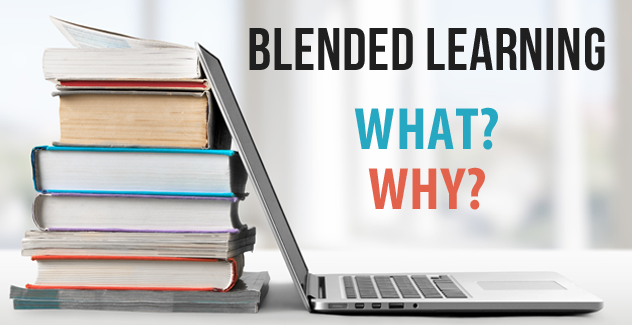
This is the first in a series of blog posts addressing various aspects of blended learning. In this post, we discuss what blended learning is and how to structure your course to make it successful for both educators and students.
Today, teachers at all levels of instruction and in all disciplines likely make use of online tools, services and information. In a face-to-face class, Internet resources supplement what is supplied by the instructor and print materials, while online learning and course management services facilitate student coursework and help track learning progress. In completely online courses, the Internet supplies the medium of instruction, and interactions with peers, instructor, and materials occur digitally. Increasingly popular today is blended or hybrid learning, which combines the best features of face-to-face and online courses.
What is Blended Learning?
Typically, a blended course format involves substantial online learning activities, which may substitute for some in-person class sessions.
I regularly teach a three-credit course on intercultural communication in a blended format (see syllabus), which I’ll use here as an example (not a model!). We meet together in the classroom just once a week (for 75 minutes). That class time is used for discussion, group work, and student presentations. Every week students complete assignments online including watching a narrated presentation on the unit content, participating in discussion forums, and writing entries in a reflective journal. Other course assignments are no different from those in a face-to-face class, including reading the textbook and selected essays, as well as watching assigned video clips. Students also write two short papers, give both individual and group presentations, and take a final examination.
Why Use a Blended Learning Approach?
I have found, as have others, that there are a number of benefits to using a blended learning approach:
- Online lectures provide flexibility. Hybrid courses often use a “flipped classroom“ approach, through which lectures are digitized and viewed outside of class. This enables students to watch on their own schedules. The digital format allows them to pause playback, re-watch segments, skip ahead, or slow down. For my course, digitized lectures are integrated into online tutorials (example).
- Class meetings can be dedicated to active student learning. In-person meetings are used for discussion and group work. This provides as well the opportunity to clarify issues coming up online or to explore further topics of interest. In my course, class meetings are also used for individual and group presentations.
- Online interactions with course content can intensify learning. Extensive use of online writing through discussion boards and journals supplements and complements in-class discussions, while providing an opportunity for more thoughtful responses and allowing all students a voice in discussions.
- Social learning is enhanced. The online discussions enable and encourage peer-to-peer interactions, individual instructor-student dialogs, and possible interactions with those outside the class. The format creates an inviting collaborative space. For the intercultural course, students have regular telecollaborative sessions with students from a foreign partner university; this semester they will be conducting 5 half-hour Skype sessions with Chinese students.
- Digital literacy is an important by-product. The blended learning format facilitates development of digital literacy (for both teacher and student) as normally a variety of technology tools and services will be used, including collaborative tools, video recording software, as well as blogs and other social platforms.
Setting up a course to be taught in a blended learning format is not something to be undertaken lightly. As stated above, it will require familiarity with various digital tools/services. It also necessitates careful consideration of whether course objectives and curricular considerations align with this format. There are adjustments necessary for students as well. In addition to technology know-how, students will need better time management and learner autonomy than is the case for face-to-face courses. That translates into the need to offer more support for students. That will include providing up front clear information on assignments and activities.
Did you enjoy this? Here are some other posts in our blended learning series:
- Designing for Blended Learning (Is it Right for You?): we discuss what factors to consider when you’re thinking about redesigning a course for blended delivery.
- Implementing Blended Learning: we discuss the implementation of a blended course and the upfront planning involved.
- Blended Learning Models for Higher-Ed and K-12: we discuss the different available models of blended learning for both higher-ed and K-12 schools.
SoftChalk Cloud makes it easy to create online tutorials like the example referenced above. Visit the SoftChalk Cloud Overview page to learn more about creating interactive online lessons like Dr. GJ’s, and then try it yourself with a free trial of SoftChalk Cloud.
About Robert Godwin-Jones, Ph.D.: Robert Godwin-Jones, Ph.D., is a founding partner and responsible for product research and design. Prior to SoftChalk, Robert was a founding partner of madDuck Technologies where he was a co-developer of the Web Course in a Box Learning
Management System. He is the former Director of the Instructional Development Center at Virginia Commonwealth University and is currently a faculty member in their School of World Studies. His principal areas of research are in applied linguistics and international studies. He writes a regular column on emerging technologies for the peer-reviewed journal Language Learning & Technology (llt.msu.edu) and blogs on intercultural communication at http://acrossculturesweb.com/wp/.

Leave a Reply